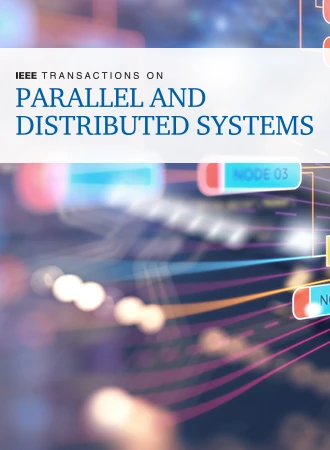瑞波:在边缘实现去中心化重复数据删除
IF 5.6
2区 计算机科学
Q1 COMPUTER SCIENCE, THEORY & METHODS
IEEE Transactions on Parallel and Distributed Systems
Pub Date : 2024-11-07
DOI:10.1109/TPDS.2024.3493953
引用次数: 0
摘要
边缘计算具有确保低数据检索延迟和减少回程网络流量的优势,正在成为许多延迟敏感型应用的骨干解决方案。越来越多的数据在边缘产生,使边缘存储系统的有限容量捉襟见肘。近年来,提高边缘存储系统的资源利用率已成为一项重大挑战。现有的解决方案试图通过数据放置优化、数据分区、数据共享等来实现这一目标。这些方法忽视了边缘存储系统中的数据冗余,从而造成大量存储资源浪费。因此,我们需要一种边缘重复数据删除方法。然而,现有的重复数据删除方法依赖于集中控制,这在实际的边缘计算环境中并不总是可行的。本文介绍的 Ripple 是第一种能让边缘服务器以分散方式重复数据删除的方法。它的核心是为每个边缘服务器建立一个数据索引,使它们能够在没有中央控制的情况下重复数据。利用 Ripple,边缘服务器可以:1)识别重复数据;2)在不违反数据检索延迟约束的情况下删除冗余数据;3)确保重复数据删除后的数据可用性。在测试平台系统中进行的跟踪实验结果证明了 Ripple 在实践中的实用性。与最先进的方法相比,Ripple 将重复数据删除率提高了 16.79%,并将数据检索延迟平均降低了 60.42%。本文章由计算机程序翻译,如有差异,请以英文原文为准。
Ripple: Enabling Decentralized Data Deduplication at the Edge
With its advantages in ensuring low data retrieval latency and reducing backhaul network traffic, edge computing is becoming a backbone solution for many latency-sensitive applications. An increasingly large number of data is being generated at the edge, stretching the limited capacity of edge storage systems. Improving resource utilization for edge storage systems has become a significant challenge in recent years. Existing solutions attempt to achieve this goal through data placement optimization, data partitioning, data sharing, etc. These approaches overlook the data redundancy in edge storage systems, which produces substantial storage resource wastage. This motivates the need for an approach for data deduplication at the edge. However, existing data deduplication methods rely on centralized control, which is not always feasible in practical edge computing environments. This article presents Ripple, the first approach that enables edge servers to deduplicate their data in a decentralized manner. At its core, it builds a data index for each edge server, enabling them to deduplicate data without central control. With Ripple, edge servers can 1) identify data duplicates; 2) remove redundant data without violating data retrieval latency constraints; and 3) ensure data availability after deduplication. The results of trace-driven experiments conducted in a testbed system demonstrate the usefulness of Ripple in practice. Compared with the state-of-the-art approach, Ripple improves the deduplication ratio by up to 16.79% and reduces data retrieval latency by an average of 60.42%.
求助全文
通过发布文献求助,成功后即可免费获取论文全文。
去求助
来源期刊

IEEE Transactions on Parallel and Distributed Systems
工程技术-工程:电子与电气
CiteScore
11.00
自引率
9.40%
发文量
281
审稿时长
5.6 months
期刊介绍:
IEEE Transactions on Parallel and Distributed Systems (TPDS) is published monthly. It publishes a range of papers, comments on previously published papers, and survey articles that deal with the parallel and distributed systems research areas of current importance to our readers. Particular areas of interest include, but are not limited to:
a) Parallel and distributed algorithms, focusing on topics such as: models of computation; numerical, combinatorial, and data-intensive parallel algorithms, scalability of algorithms and data structures for parallel and distributed systems, communication and synchronization protocols, network algorithms, scheduling, and load balancing.
b) Applications of parallel and distributed computing, including computational and data-enabled science and engineering, big data applications, parallel crowd sourcing, large-scale social network analysis, management of big data, cloud and grid computing, scientific and biomedical applications, mobile computing, and cyber-physical systems.
c) Parallel and distributed architectures, including architectures for instruction-level and thread-level parallelism; design, analysis, implementation, fault resilience and performance measurements of multiple-processor systems; multicore processors, heterogeneous many-core systems; petascale and exascale systems designs; novel big data architectures; special purpose architectures, including graphics processors, signal processors, network processors, media accelerators, and other special purpose processors and accelerators; impact of technology on architecture; network and interconnect architectures; parallel I/O and storage systems; architecture of the memory hierarchy; power-efficient and green computing architectures; dependable architectures; and performance modeling and evaluation.
d) Parallel and distributed software, including parallel and multicore programming languages and compilers, runtime systems, operating systems, Internet computing and web services, resource management including green computing, middleware for grids, clouds, and data centers, libraries, performance modeling and evaluation, parallel programming paradigms, and programming environments and tools.
 求助内容:
求助内容: 应助结果提醒方式:
应助结果提醒方式:


